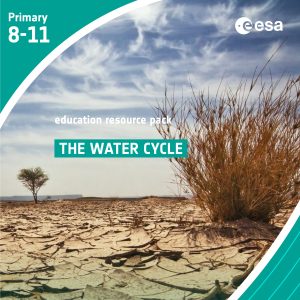The Water Cycle
In this set of six activities, students will learn about the water cycle and, in particular, how water in the soil contributes to the cycle and responds to changes in it. A set of practical activities allow students to look more closely at the processes of evaporation and condensation from free water and water in the soil. By using real satellite data students explore changes in soil moisture across the world over recent years.
Subject Geography, Science, Earth Science
- Describe how water changes state changes in the context of the water cycle
- Apply knowledge about the water cycle to suggest how it might change as a result of global heating
- Evaluate and carry out an experimental procedure
- Record detailed observations
- Recognise the role of soil and plants in the water cycle
- Relate the results of the experiment to the role of soils in the water cycle
- Use the Climate from Space web application and real satellite date
- Integrate information from a range of sources to present a concise summary of independent research
Activity 1: The water cycle today and tomorrow
- Three cups or small trays or bowls for each group
- Three sticky labels or a marker
- Water
- Rulers – preferably ones with zero at the edge
- Towels for wet hands and to deal with any spills
- A copy of Student worksheet 2 (2 pages) for each student
- Graph paper (optional)

- A transparent bottle or jar with a tight-fitting lid for each group
- Sticky label or marker
- Food colouring or ink
- A jug or beaker for each group
- A funnel for each group (not essential but reduces splashing)
- Towels for wet hands and to deal with any spills
- Student worksheet 3 – one copy per student
- Camera (e.g. smartphone) for each group
- Presentation, image- or/and word-processing software with which students are familiar (if using cameras)

- Two identical pots or paper cups for each group, one containing a plant and one just soil
- Sticky labels or marker
- Two clear plastic bags for each group
- Elastic bands (depending on bags used)
- Dustpan and brush to deal with spills
- Student worksheet 4 – one copy per student
- A pot with holes in the bottom filled with soil for each group
- A small tray or dish for the pot to stand on
- Measuring cylinder or cup that can measure 25 cm3 and 50 cm3 for each group
- A jug or large beaker of water for each group
- A timer or stopwatch per group
- A copy of Student worksheet 5 (2 pages) for each student
- Empty pots identical to those filled with soil (optional)
- Towels for wet hands and to deal with any spills
- Internet access
- Climate from Space web application
- Student worksheet 6 (2 pages)
- Presentation software such as PowerPoint (optional)
- Materials for making a poster (optional)
Did you know?
As the Sun heats the Earth, warm moist air rises from the surface of the land, the oceans and other bodies of water; the water vapour in the air condenses forming clouds; when the water droplets in the cloud are heavy enough, they fall back to Earth as rain or snow. Rainwater and melting snow and ice may flow back to the ocean or seep into the ground. Water that soaks into the earth may collect in underground aquifers or be taken up by the roots of plants that eventually send it
back out into the air. This water cycle is crucial to sustaining life on Earth and we depend on the freshwater that cycles through it for hygiene and industry as well as for drinking and growing our food.

Paxi explores wind
Brief description: Learn about wind, what causes it and how and why we study it in the latest Paxi adventure...
Weather vs Climate – Understanding the difference between weather and climate
Brief description In this set of three activities, students will learn the difference between weather and climate. They will identify...
Country under Threat – The prospects for life on small islands
Brief description In this set of four activities pupils will learn about the causes and potential impacts of sea-level rise...
Is ozone good or bad? -The discovery of the Antarctic ozone hole
Brief description In this set of three activities, students will learn about ozone and the impacts – good and bad...
Astro farmer
Brief description:In this set of six activities, students will investigate which factors affect plant growth, and relate these factors to...
Highways of the Oceans – Sea currents and the connection to climate
Brief description In this set of three activities, students will use an multimedia module to learn about sea currents, the...



